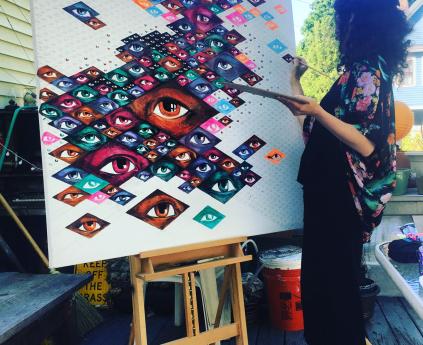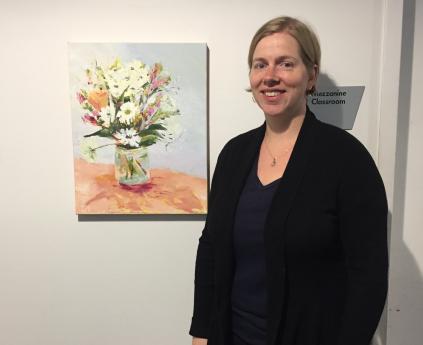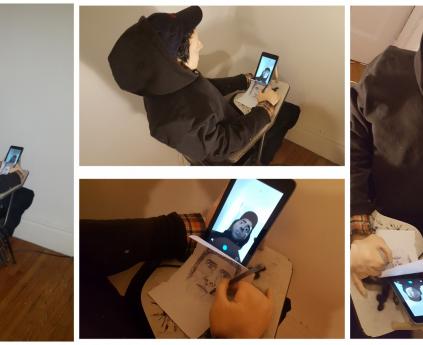
by Aneleise Ruggles | March 11, 2019
Artist Name:
Shelby Meyerhoff
Where are you from?
Winchester, MA
What is your primary artistic medium?
Body paint and Photography
Please talk a little bit about your artistic practice. What does your creative process look like? Where do you create your artwork? How long does one piece take to create from start to finish?
To create the images in my Zoomorphics series, I transform my appearance using body paint and photograph myself as different creatures inspired by the natural world. Often a walk in the woods will give me new ideas, based on the plants, animals, and fungi that I encounter there. My next step is to take or find reference photos. Macro (close-up) photographs that allow me to see fine details are particularly useful, because so much of my work is about evoking the textures found in nature. I also make preparatory sketches, with watercolor or face paint on paper.
Then I set aside a full day to transform myself and make the final photograph, including 4-5 hours of painting and 2 hours of shooting. I paint in front of a mirror, using professional-quality face paints. I take the photographs with a digital camera, a tripod, and an iPhone app that allows me to remote control the camera. I love to shoot outdoors in warm enough weather. But this being Boston, some of my most effective images have been made indoors with relatively simple backdrop and lighting equipment.
Because I only have one afternoon or evening to get the shot before I have to wash the painting off, I often take hundreds of photographs, to ensure I got the right one. It’s an exciting moment when I view the photographs on the computer for the first time and find the one that just works. It should provoke a visceral reaction, moving me to smile, laugh, or stare. And in that moment, I see for the first time exactly what this creature is that I have created, how the painting, photography, and modeling are all working together to bring it to life.
How do you approach creating a self-portrait?
For me, creating these images is playful, engaging, and meaningful. Playful in the sense that I give myself permission to explore a full range of possibilities. This is different than many other forms of portraiture. We all know what is expected from us when we sit for a school portrait, a family photo, or a professional headshot. We know or receive instructions telling us what to wear, whether and how to smile, and how to pose our bodies in relation to the camera.
I enjoy having the chance to play around, contorting my face in weird ways, changing up my poses, trying to figure out how to embody this new creature. Because my creatures are hybrids, brought to life in a human body but based on other living organisms, they don’t have to conform to social expectations.
At the same time, I feel the best images emerge when I am deeply engaged in creating the work, when the creature I am becoming has emotional resonance for me. That’s where the meaning develops. Often I start out just knowing that for some reason, a particular plant or animal interests me. But by the time I’m finished and can see what qualities emerged in the final image, I understand much more about why that creature spoke to me.

Why do you choose to create self-portraits? Why do you think it is important for artists to create self-portraits?
As a woman, I see creating my own self-portraits as a challenge to the power dynamics of a patriarchal society. Women’s bodies have been treated in fine art and advertising as objects onto which different meanings and motives are projected, and in body painting as undifferentiated canvasses. By working as model, painter, and photographer, I challenge these uses of the female body, taking artistic control of how my body and self are presented.
What role does social media play in your artistic practice?
Zoomorphics began as a series of selfies. Throughout October 2016, I painted a different design on myself every day and took iPhone photos, which I posted on social media. My goal was simply to develop my skills as a face and body painter. But the feedback that people offered on social media helped me to recognize the potential for this series, that I was working in an art form that could have significant meaning and impact.
In many ways, Zoomorphics is a critique of the dominant selfie culture, in which women are pressured to meet mainstream standards of beauty and femininity. Instead, I use body paint and photography to represent myself in a way that aligns with my own aesthetic and intellectual interests.

How do you think a stranger may "perceive" you based on the work that you create?
One of the biggest surprises to me is how many people have told me they find the images from Zoomorphics to be frightening or unsettling. There’s only one image in the series in which I intentionally tried to look scary (Zoomorphic #9, based on a spider). But people have had this reaction to a number of the photographs. Perhaps it is a case of “uncanny valley,” as one viewer suggested, of seeing something that is both human and not-human at the same time.
When I showed my work to an audience at a recent artist’s talk, a couple of the images made people laugh. I really enjoyed hearing that; I have a lot of fun making these photographs and I’m glad that comes through.
How do you think a stranger may "perceive" you based on your social media profile(s)?
I’m very intentional in my use of social media, which I see as a powerful tool for starting conversations, building relationships, and fostering political and social movements. Before becoming an artist, I worked as an online communications strategist for nonprofits. As a result, my Facebook profile has always been a place for me to share the personal, the professional, and the political, and to do so with people from many different parts of my life. I post new artwork on a regular basis, but I also post about grassroots fundraising events to support climate activism, the campaign to protect the local woods from development, and other meaningful opportunities for political action.
In terms of my artwork, when I share a new Zoomorphics piece on social media, often I write reflections to accompany the image, describing what inspired that work. I’m always trying to connect with viewers so that they don’t feel like strangers as they encounter these photographs, and social media provides genuine opportunities to build relationships between viewers and artists. It’s meaningful for me to feel that I’m creating work to share with a community of people, both online and in the world.
Learn More:






